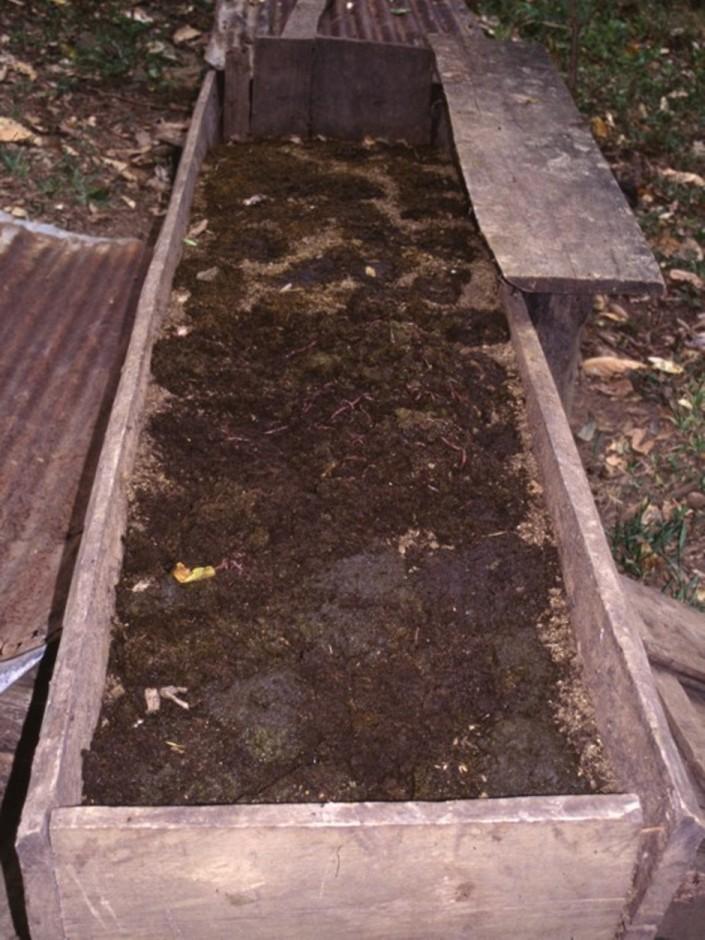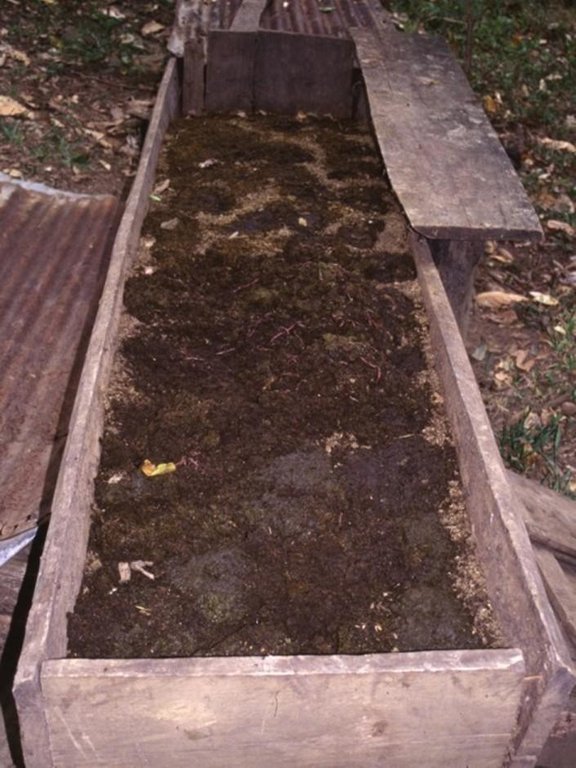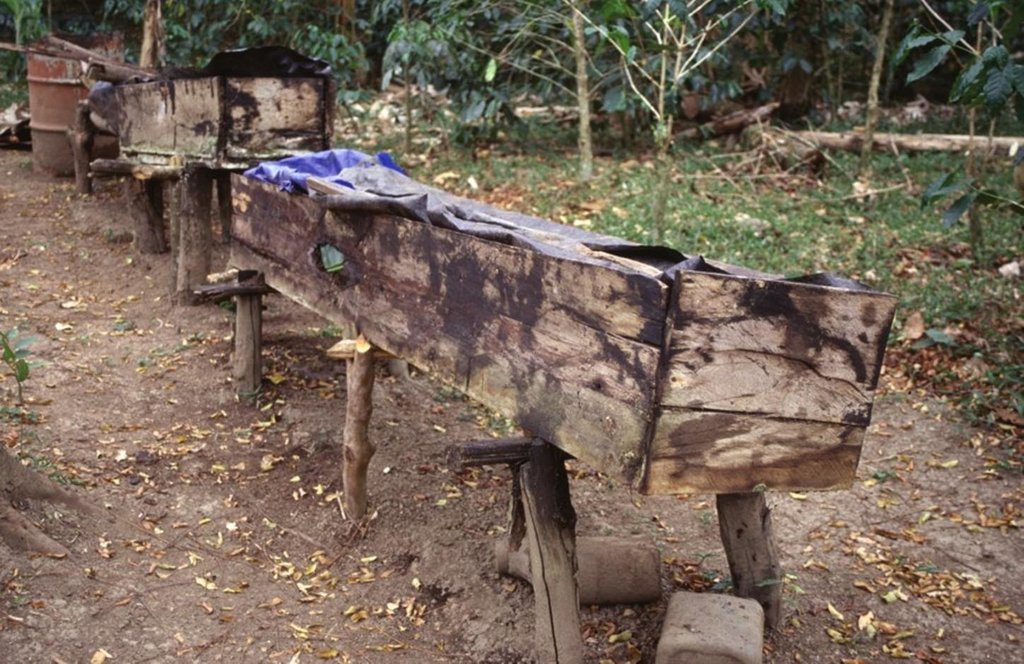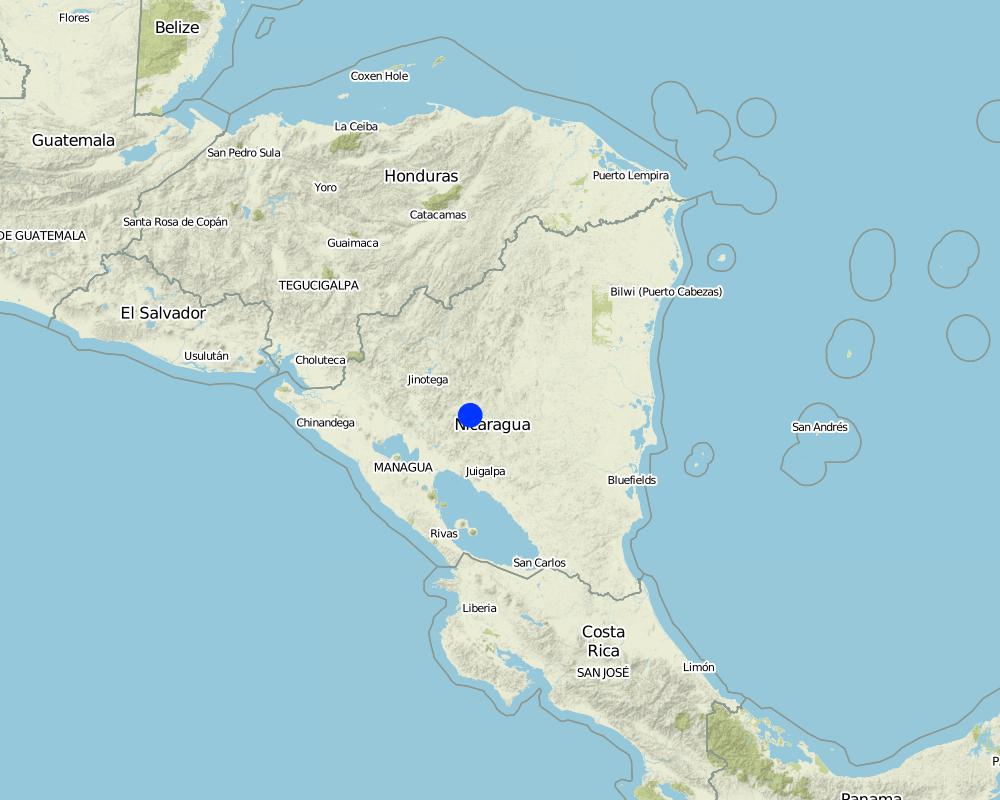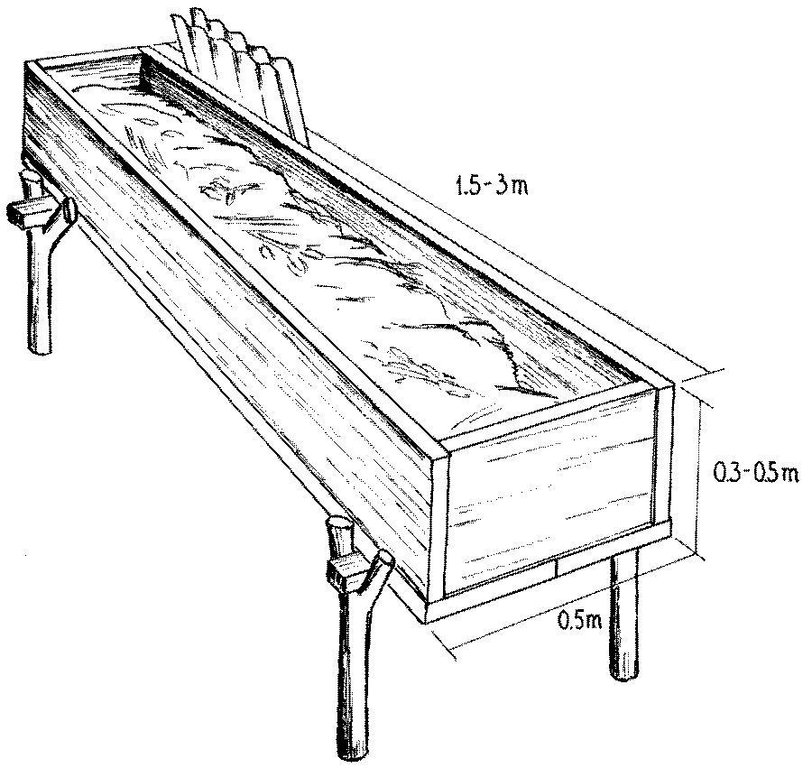Vermiculture [Никарагуа]
- Шинийг нээх:
- Шинэчлэх:
- Эмхэтгэгч: Ramén Ernesto Caceres Ordonez
- Хянан тохиолдуулагч: –
- Хянагчид: Deborah Niggli, Alexandra Gavilano
Lombricultura
technologies_1022 - Никарагуа
Бүлгүүдийг үзэх
Бүгдийг дэлгэх Бүгдийг хаах1. Ерөнхий мэдээлэл
1.2 Технологийг үнэлэх, баримтжуулах ажилд хамаарах мэдээлэл өгсөн хүмүүс, байгууллагуудын холбоо барих мэдээлэл
ГТМ мэргэжилтэн:
Gómez Martínez Julio César
De ENITEL
Никарагуа
Технологи баримтжуулах/үнэлэх ажилд дэмжлэг үзүүлсэн төслийн нэр (шаардлагатай бол)
Book project: where the land is greener - Case Studies and Analysis of Soil and Water Conservation Initiatives Worldwide (where the land is greener)1.3 ВОКАТ-аар баримтжуулсан өгөгдлийг ашиглахтай холбоотой нөхцөл
Эмхэтгэгч болон гол мэдээлэгч хүн(хүмүүс) WOCAT аргачлалаар баримтжуулсан мэдээллийг ашиглахтай холбоотой нөхцлийг хүлээн зөвшөөрсөн:
Тийм
1.4 Технологи тогтвортой гэдгийг баталгаажуулах
Энэ технологийг газрын доройтлыг бууруулж, газрын тогтвортой менежментийг хангахад тохиромжтой гэж үзэж болох уу?
Үгүй
1.5 ГТМ Арга барилын Асуулга (ууд) руу хандах (ВОКАТ ашиглан баримтжуулсан)

Productive development and food security programme [Никарагуа]
An integrated programme-based approach promoting participatory testing and extension of various SWC technologies, as well as providing institutional support.
- Эмхэтгэгч: Philippe Zahner
2. ГТМ Технологийн тодорхойлолт
2.1 Технологийн товч тодорхойлолт
Технологийн тодорхойлолт:
Continuous breeding of earthworms in boxes for production of high quality organic compost.
2.2 Технологийн дэлгэрэнгүй тодорхойлолт
Тодорхойлолт:
Vermiculture is a simple and cheap way to produce a continuous supply of organic compost of high quality. Eisenia foetida, the Red Californian earthworm (also called ‘the red wiggler’) is ideal for vermiculture since it is adapted to a wide range of environmental conditions. Under culture, the worms are kept under shade, in long wooden boxes filled with earth, cattle manure and an absorbent material (eg straw). The box is covered by sheet metal (or wood, thick plastic sheeting, or banana leaves) to protect the worms against UV radiation and birds/chickens, and also to maintain a favourably humid microclimate. Fresh cattle manure is a perfect food for the worms, but rotten coffee pulp can also be fed. Chopped crop residues (eg cowpeas, leucaena leaves or other legumes) may be added.
The compost produced by the earthworms has a dark colour, no smell and a loose and spongy structure. It is a high value, high quality product which is very rich in nutrients, and in a form that makes them readily available to vegetation. The content of a full box can be harvested every 3-4 months, and is used for crops -mainly coffee and vegetables, but also maize and beans. It is very effective in increasing soil fertility and thus crop production. It also improves soil structure, infiltration and water storage capacity.
The compost can either be applied directly to coffee, mixing it with an equal amount of earth and applying 1 kg to each plant. Alternatively it can be sprayed: for preparation of liquid fertilizer 50 kg compost are mixed with 50 litres of water and left to soak for 5 days. The concentrated solution produced is mixed with water at a ratio of 1 to10 and applied to the crop using a knapsack sprayer. The earthworms reach their reproductive age after three months and live for many years. In perfect conditions an earthworm produces up to 1,500 offspring per year. Thanks to their rapid reproduction, new cultures can easily be established, or earthworm stocks can be sold according to the farmer’s needs. A certain amount
of earthworm compost is kept back and being used instead of fresh earth to reinitiate the whole process, or to start new cultures.
The area is characterised by humid climate, steep slopes and low soil fertility. Farmers are mainly smallholders with individual properties. Earthworm culture does not depend closely on the external environment, but it is essential to maintain favourable conditions inside the box - namely continuous feeding and wetting. That’s why it is usually recommended to keep cultures near the house and the home-garden. Ants, the main enemy of earthworms, can be controlled standing the boxes on poles in cans filled with water.
2.3 Технологийн гэрэл зураг
2.5 Энэ үнэлгээнд хамрагдсан технологийг хэрэгжүүлсэн улс орон/ бүс нутаг/ байршил
Улс:
Никарагуа
Улс/аймаг/сум:
Matagalpa
Байршлын дэлгэрэнгүй тодорхойлолт:
Matiguas, Pancasán
Тайлбар:
Total area covered by the SLM Technology is 5 m2.
Map
×2.7 Технологийн танилцуулга
Технологийг хэрхэн нэвтрүүлснийг тодорхойл:
- Гадны төсөл/хөтөлбөрийн дэмжлэгтэйгээр
3. ГТМ технологийн ангилал
3.1 Технологийн үндсэн зорилго (ууд)
- биологийн төрөл зүйлийг хамгаалах / сайжруулах
3.2 Технологи нэвтрүүлсэн газрын одоогийн газар ашиглалтын хэлбэр(үүд)

Тариалангийн талбай
- Нэг наст үр тариа
- Олон наст (модлог биш) үр тариа
Жилд ургамал ургах улирлын тоо:
- 1
Тодорхойлно уу:
Longest growing period in days: 300, Longest growing period from month to month: May untill February
Тайлбар:
Major land use problems (compiler’s opinion):
- low crop yields due to soil fertility decline
- water and wind erosion
- small landholdings
3.4 Усан хангамж
Технологи хэрэгжүүлсэн газрын усан хангамж:
- Байгалийн усалгаатай
3.5 Технологи ГТМ-ийн аль бүлэгт хамаарах вэ
- Хөрсний үржил шимийн нэгдсэн менежмент
- Зөгийн аж ахуй, загасны аж ахуй, тахиа үржүүлэг, туулай үржүүлэг, торгоны хүүхэлдэйн аж ахуй г.м
3.6 Технологийг бүрдүүлэх ГТМ арга хэмжээ

Агрономийн арга хэмжээ
- А4: Хөрсний үе давхаргыг сайжруулах
Тайлбар:
Type of agronomic measures: manure / compost / residues
3.7 Технологид харгалзах газрын доройтлын төрөл

хөрсний химийн доройтол
- Cn: Үржил шим ба ялзмаг буурах (элэгдлийн шалтгаангүй)
Тайлбар:
Main causes of degradation: soil management, deforestation / removal of natural vegetation (incl. forest fires), overgrazing (on a single cattle farm), poverty / wealth (lack of capital)
Secondary causes of degradation: over-exploitation of vegetation for domestic use, other natural causes (avalanches, volcanic eruptions, mud flows, highly susceptible natural resources, extreme topography, etc.) specify (impacts of hurricane Mitch), governance / institutional (lack of strenght of law and authorities), inter-generational subdivision of land
3.8 Газрын доройтлоос урьдчилан сэргийлэх, сааруулах ба нөхөн сэргээх
Газрын доройтолтой холбоотойгоор Технологи ямар зорилго тавьсан болохыг тодорхойл:
- Газрын доройтлыг бууруулах
4. Техникийн нөхцөл, хэрэгжүүлсэн үйл ажиллагаа, материал ба зардал
4.1 Технологийн техник зураг
Техник тодорхойлолт (техник зургийн тайлбар):
Detailed view of wooden box for compost production by earthworms. Cover (corrugated iron or alternative) is important to protect worms from light, from birds and other natural enemies, and to maintain moisture in the box.
Technical knowledge required for field staff / advisors: moderate
Technical knowledge required for land users: moderate
Main technical functions: increase of surface roughness, improvement of topsoil structure (compaction), increase in organic matter, increase in nutrient availability (supply, recycling,…)
Secondary technical functions: increase of infiltration
Manure / compost / residues
Material/ species: compost
Зохиогч:
Mats Gurtner
4.4 Бий болгоход шаардагдсан зардал, хөрөнгийн өртөг
| Зардлын нэр, төрөл | Хэмжих нэгж | Тоо хэмжээ | Нэгжийн үнэ | Зардал бүрийн нийт өртөг | Нийт дүнгээс газар ашиглагчийн төлсөн % | |
|---|---|---|---|---|---|---|
| Хөдөлмөр эрхлэлт | labour | ha | 1.0 | 6.0 | 6.0 | 100.0 |
| Барилгын материал | wood | ha | 1.0 | 50.0 | 50.0 | 100.0 |
| Барилгын материал | Sheet metal, plastic | ha | 1.0 | 6.0 | 6.0 | 100.0 |
| Бусад | earthworms (kg) | ha | 1.0 | 60.0 | 60.0 | |
| Технологи бий болгох нийт үнэ өртөг | 122.0 | |||||
| Технологи бий болгох нийт үнэ өртөг, ам.доллар | 122.0 | |||||
Тайлбар:
Duration of establishment phase: 0.07 month(s)
4.5 Арчилгаа/ урсгал үйл ажиллагаа
| Үйл ажиллагаа | Хугацаа/ давтамж | |
|---|---|---|
| 1. | 1. Feeding: add another layer of cattle manure(1 kg earthworms eat 1 kg manure per day). | no specific timing for maintenance / every 3–5 days |
| 2. | 2. Maintain humidity at 80%, water frequently in dry season, maintaintemperature between 15–30°C: do not exceed 42°C. | no specific timing for maintenance / frequently in dry season |
| 3. | 3.The worms migrate into the fresh manure. After 2–3 days take out thesieve and gather the ready, worm free compost. | no specific timing for maintenance / every 3–4 months |
| 4. | 4. Apply compost to the crops (1 kg/coffee plant, see description). | no specific timing for maintenance / every 3–4 months |
| 5. | 6. Possible improvement: add lime to raise pH to a optimum level of 7.0. | no specific timing for maintenance / |
4.6 Арчилгаа/урсгал ажилд шаардагдсан зардал, хөрөнгийн өртөг (нэг жилд)
| Зардлын нэр, төрөл | Хэмжих нэгж | Тоо хэмжээ | Нэгжийн үнэ | Зардал бүрийн нийт өртөг | Нийт дүнгээс газар ашиглагчийн төлсөн % | |
|---|---|---|---|---|---|---|
| Хөдөлмөр эрхлэлт | labour | ha | 1.0 | 60.0 | 60.0 | 100.0 |
| Технологийн арчилгаа/урсгал үйл ажиллагаанд шаардагдах нийт үнэ өртөг | 60.0 | |||||
| Технологи арчилах ба урсгал ажлын нийт үнэ өртөг, ам.доллар | 60.0 | |||||
Тайлбар:
Machinery/ tools: hammer, nails, buckets/wheelbarrow, shovel, possibly water hose, hammer, nails, buckets/wheelbarrow, shovel, possibly water hose
60% of the land users have their own cattle, others get manure free from their neighbours. The cattle manure has no commercial price in the region - there is no market for it. The inputs and costs are estimated for the production of approx. 4,000 kg of worm compost, which is enough for one hectare of coffee per year (note figures from India for vermiculture suggest higher input-output ratios: in other words less output for the same amount of input).
5. Байгаль ба нийгмийн нөхцөл
5.1 Уур амьсгал
Жилийн нийлбэр хур тундас
- < 250 мм
- 251-500 мм
- 501-750 мм
- 751-1,000 мм
- 1,001-1,500 мм
- 1,501-2,000 мм
- 2,001-3,000 мм
- 3,001-4,000 мм
- > 4,000 мм
Агро-уур амьсгалын бүс
- чийглэг
- чийглэг
Thermal climate class: tropics
5.2 Гадаргын хэлбэр
Дундаж налуу:
- хавтгай (0-2 %)
- бага зэрэг налуу (3-5 %)
- дунд зэрэг налуу (6-10 % )
- хэвгий (11-15 %)
- налуу (16-30 %)
- их налуу (31-60 % )
- эгц налуу (>60 %)
Гадаргын хэлбэр:
- тэгш өндөрлөг / тал
- нуруу
- уулын энгэр
- дов толгод
- бэл
- хөндий
Өндрийн бүслүүр:
- 0-100 д.т.д. м.
- 101-500 д.т.д. м.
- 501-1,000 д.т.д м.
- 1,001-1,500 д.т.д м.
- 1,501-2,000 д.т.д м.
- 2,001-2,500 д.т.д. м.
- 2,501-3,000 д.т.д. м.
- 3,001-4,000 д.т.д м.
- > 4,000 д.т.д. м.
5.3 Хөрс
Хөрсний дундаж зузаан:
- маш нимгэн (0-20 см)
- нимгэн (21-50 см)
- дунд зэрэг зузаан (51-80 см)
- зузаан (81-120 cм)
- маш зузаан (>120 cм)
Хөрсний бүтэц (өнгөн хөрс):
- нарийн /хүнд (шаварлаг)
Өнгөн хөрсөнд агуулагдах ялзмаг:
- бага (<1 % )
5.6 Технологи нэвтрүүлсэн газар ашиглагчдын тухай мэдээлэл
Үйлдвэрлэлийн системийн зах зээлийн чиг баримжаа:
- амь зуух арга хэлбэрийн (өөрийгөө хангах)
- холимог (амьжиргаа ба худалдаанд)
Бусад эх үүсвэрээс олох орлого:
- Нийт орлогын 10 %-иас доош
Газар ашиглагчдын бусад шинж чанарыг тодорхойл:
Off-farm income specification: nearly all land users are fully occupied with agricultural activities, very few are involved in commerce or are employed
5.7 Газар ашиглагчийн технологи нэвтрүүлсэн газрын дундаж талбайн хэмжээ
- < 0.5 га
- 0.5-1 га
- 1-2 га
- 2-5 га
- 5-15 га
- 15-50 га
- 50-100 га
- 100-500 га
- 500-1,000 га
- 1,000-10,000 га
- > 10,000 га
5.8 Газар эзэмшил, газар ашиглах эрх, ус ашиглах эрх
Газар өмчлөл:
- хувь хүн, өмчийн гэрчилгээгүй
- хувь хүн, өмчийн гэрчилгээтэй
Газар ашиглах эрх:
- түрээсийн хэлбэрээр
- хувь хүн
6. Үр нөлөө ба дүгнэлт
6.1 Технологийн талбайд үзүүлсэн нөлөө
Нийгэм-эдийн засгийн үр нөлөө
Үйлдвэрлэл
газар тариалангийн үйлдвэрлэл
тэжээл үйлдвэрлэл
тэжээлийн чанар
Орлого, зарлага
тухайн аж ахуйн орлого
Нийгэм-соёлын үр нөлөө
маргааныг шийдвэрлэх
Экологийн үр нөлөө
Хөрс
хөрсний чийг
Тайлбар/ тодорхой дурьдах:
through improvement of soil water storage capacity
Биологийн олон янз байдал: ургамал, амьтан
хортон шавж/өвчний хяналт
Тайлбар/ тодорхой дурьдах:
the compost attracts pests like ants, chickens, moles
6.2 Технологийн талбайн гадна үзүүлсэн үр нөлөө
газар доорхи ус/голын усны бохирдол
Тайлбар/ тодорхой дурьдах:
lower inputs of chemical fertilizers
6.5 Технологи нэвтрүүлэлт
Тайлбар:
88 land user families have adopted the Technology with external material support
6 land user families have adopted the Technology without any external material support
There is a little trend towards spontaneous adoption of the Technology. As ADDAC (the Association for Agricultural Community Development and Diversification) has a permanent and longterm presence in the approach area, most interested farmers are directly involved in the programme activities: this explains the fact that only 5% of the technology users (6 people) took up earthworm culture without incentives (see approach).
6.7 Технологийн давуу тал/боломжууд
| Газар ашиглагчдын тодорхойлсон давуу тал/боломжууд |
|---|
| Additional economic income through commercialization of earthworm stocks |
| Health: clean products without chemical treatment. |
| Эмхэтгэгч, бусад мэдээлэл өгсөн хүмүүсийн өнцгөөс тодорхойлсон давуу тал/боломжууд |
|---|
| Continuous and increasing production of organic and very effective compost with high nutrient content (replacing chemical fertilizers) |
|
Appropriate for different crops (though in different forms – direct application or spraying). |
| Simple and cheap technology; low labour input |
| Increased crop yields |
| Earthworm culture is becoming an integrated part of the production system, especially for land users who have cows. |
6.8 Технологийн дутагдалтай/сул тал/аюул болон тэдгээрийг хэрхэн даван туулах арга зам
| Эмхэтгэгч, бусад мэдээлэл өгсөн хүмүүсийн өнцгөөс тодорхойлсон сул тал/ дутагдал/ эрсдэл | Тэдгээрийг хэрхэн даван туулах вэ? |
|---|---|
| Requires permanent access to water | A close fitting and secure box cover, as well as placement of the box in the shade reduces loss of humidity. Roof-top rainwater collection helps to get over dry periods. |
| Requires continuous availability of manure to feed worms. | Improve the construction of the boxes (close holes and cover the box tightly). |
| Attracts natural enemies like ants, chickens, moles, flies; needs protection |
7. Ном зүй ба холбоосууд
7.1 Мэдээлэл цуглуулсан арга/эх үүсвэр
- Хээрийн уулзалт, судалгаа
- Газар ашиглагчтай хийсэн ярилцлага
Мэдээллийг хэзээ (газар дээр нь) цуглуулсан бэ?
01/02/2004
7.2 Ном, хэвлэлийн ишлэл
Гарчиг, зохиогч, он, ISBN:
PASOLAC. Guía Técnica de Conservación de Suelos y Agua.. 2000.
Хаанаас авч болох вэ? Зардал?
PASOLAC, Managua
Гарчиг, зохиогч, он, ISBN:
Ferruzzi C. Manual de Lombricultura. Ediciones Mundi-Prensa. Madrid, Spain. 1986.
Гарчиг, зохиогч, он, ISBN:
Castillo H . La lombricultura. in Altertec. Alternativas de Mejoramiento de Suelos.Proceso de Capacitación para Profesionales. Modulo II. Altertec, Ciudad de Guatemala. 1994.
Холбоос ба модулууд
Бүгдийг дэлгэх Бүгдийг хаахХолбоосууд

Productive development and food security programme [Никарагуа]
An integrated programme-based approach promoting participatory testing and extension of various SWC technologies, as well as providing institutional support.
- Эмхэтгэгч: Philippe Zahner
Модулууд
Модуль байхгүй байна


